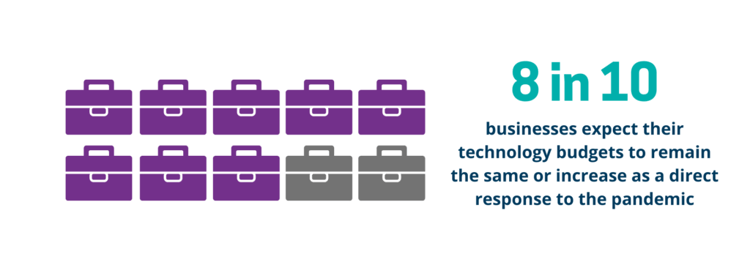8 Top Tips When Forecasting Your IT Budget
by Conosco on Jan 19, 2021

Written by Amit Dattani, Director of Technology at Conosco
2020 was a challenging year for many businesses, however, those that have remained agile and invested in new technology and operational transformation have been better equipped to deal with the rapid rate of change. As we begin to formulate technology strategies for 2021, IT leaders face an even tougher time accurately forecasting IT budgets – often balancing pressures to ‘tighten the purse strings’ with increasing demands to digitally evolve and stay competitive. According to a study by Gartner, despite the expectation that IT spend would retreat in 2020, in fact, investment in the cloud became a priority with CIOs seeking greater operational flexibility.
Whilst we continue to face uncertainty going into 2021, many IT leaders remain optimistic about their digital growth with 8 in 10 businesses expecting their tech budgets to remain the same or increase as a direct response to the pandemic. That said it’s important to spend wisely – the allure of new technologies such as IoT, AI and 5G has many organisations racing to get ahead of the curve.
In this blog, we share our top 8 tips for ensuring accurate IT budgeting.
- Understand the business goals
- Create ‘budgeting buckets’
- Perform benchmarking exercises
- Allocate costs appropriately
- Continuously review and optimise IT budget
- Build a plan for IT spend
- Ensure flexibility
- Implement KPIs
What is IT Budgeting?
Although usually completed annually, IT budgeting can be a painful and time-consuming exercise.
The IT budget will often include:
- IT staffing costs including external consultants
- The cost of building and maintaining back-office systems e.g. HR, finance, ERP applications
- Hardware expenses i.e. servers, laptops, mobile devices, networking equipment
- Cloud/data storage expenses
There may be additional technology costs that fall outside of an IT budget and sit with other departments. For example, a content management system (CMS) would usually come out of the marketing budget. However, that is not to say that IT shouldn’t be aware of technology spend in other areas of the business.
IT should have a holistic view of all technology costs regardless of where they sit within the business, not only does it keep the C-suite abreast of company-wide tech spend, but it enables IT to ensure that any new technology is truly necessary and fit-for-purpose.
Whilst your IT budget doesn’t always lay out the specifics, it should give a clear indication of where spend is likely to go throughout the year. For example, you may allocate a certain amount of budget to a new cloud solution, however, it will be up to the project team to decide how that budget is spent – what provider (e.g. AWS, Azure, Google) and what resources are needed to deliver the desired project outcome. The budget allows for clarity on whether the project will be approved and determines what return on investment (ROI) the forecast spend will drive.
To ensure an accurate and strategic budget is formulated for your business, we’ve highlighted 8 top tips below for a business-focused IT budgeting.

1) Understand the business’s goals (not just what IT would like to do)
A key component of IT budgeting is ensuring its alignment with the business’s overall strategic objectives. Many people within the organisation may be involved in the IT budgeting process including Chief Executives, Directors and Chief Financial Officers, however, ultimately the responsibility of the IT budget is with the most senior IT employee, such as the CIO or CTO. They will take ownership and direction of the budget and will therefore need a strong understanding of what the business is trying to achieve to ensure any proposed project and spend is aligned to the strategy.
The planning stages are critical, any disconnect between the strategy and the budget can lead to poor strategy implementation, project failure and misaligned spend. One study showed that 39% of projects fail due to carelessness when planning and strategising.
This is the first and most crucial step in creating an IT budget. Without this, the budget is likely to be a wish list from IT on desired tools and solutions with no real direction on what the business actually needs in order to achieve its plans. This can have a serious negative impact – hindering business growth and wasting money as well as resource.
2) Create ‘Budgeting Buckets’
So, what are budgeting buckets? Never heard of them.
Budgeting buckets are simply a way of creating allocations (buckets) for the forecasted IT budget. Examples of budgeting buckets may include:
- Keeping the lights on (KTLO) – IT spend needed to maintain the systems, tools, and solutions currently in situ.
- Technical Debt – IT spend needed to address any known technical debts within the current IT landscape.
- Improvements – IT spend needed to either improve existing solutions.
- Strategic Projects – IT spend needed to complete any new initiatives aligned to the business
Assigning budget to buckets allows IT leaders and department heads to analyse the types of spend being proposed. Is the budget meeting the business’s strategic objectives? Is the budget heavy on ‘keeping the lights on’ and not advancing the IT landscape with new features and functionality?
A balanced IT budget will consist of percentage proportions of each type of bucket and be tightly aligned to the business.
3) Perform Benchmarking Exercises
The previous two tips have been focused on planning and strategy. Armed with this information CIOs and CTOs will understand what challenges the business faces and the gaps in their current systems, tools, and solutions.
The next step is to perform a benchmarking exercise.
IT Benchmarking is a way of evaluating your technology, processes, systems and budget by comparing them to insights, metrics or third party solutions. For example, if you are using Microsoft Office 365, you may want to benchmark to ensure the solution is still fit for purpose and cost optimised. Perhaps you would look at an alternative solution such as G Suite and compare the features, services and for budgeting the costs of each solution.
Benchmarking will help you to:
- Better manage costs and identify opportunities to make cost savings
- Understand if your current technology is efficient and meeting your business goals
- Identify customer service and user experience improvements
- Evaluate whether you need to hire additional personnel or outsource IT support/projects
- Compare solutions based on key performance metrics
There are so many technology solutions that overlap and address similar IT challenges. When benchmarking, it is particularly important to ensure a true comparison (apples vs apples) is done to reflect potential solutions and costs.
Using the information you gain from the benchmarking exercise, you will be able to make more informed decisions about your IT and better manage costs whilst helping your business grow and providing your staff with the technology they need to thrive.
4) Allocate Costs – Capex vs Opex
Once you have confirmed what the IT budget is likely to be (total) and what the proposed projects/investments will be, you can allocate the IT budget to capital expenditure (Capex) and operational expenditure (Opex)
- Capex – refers to technology that has an upfront cost
- Opex – refers to business expenses occurred on a daily/ monthly basis.
CIOs or CTOs will often work with their CFO counterparts to allocate accordingly, as it can be a mechanism for ensuring financial leverage.
CFOs are often more likely to approve Capex budgets as they can be planned for in advance. However, whilst the spend on projects is predictable, the risk is that during the investment lifecycle, the business needs may change leaving the technology outdated and unfit for purpose. What’s more as technology ages it will likely incur maintenance and upgrade charges or even leave the business with technical debt.
As technology has evolved many services have moved online. For example, cloud computing means that businesses can remove physical equipment and pay monthly for the server capacity they need. Opex models, once seen as less favourable from a financial perspective, are now becoming more appealing. Instead of paying a large sum upfront, the smaller recurring fees free up cash for other projects that drive revenue and growth.
5) Continuously review and optimise the IT budget (don’t be afraid to reduce your IT budget)
IT spend is often seen as a necessary expense. In fact, a report by CIO magazine showed that half of IT leaders surveyed said their departments were primarily seen as ‘cost centers’ meaning they do not add profit. However, with IT becoming more strategic, inter-department communications increasing and more significant data analysis taking place, IT investments are beginning to drive process development, increase customer satisfaction, lower costs and improve ROI.
IT Budgeting should be an ongoing exercise and not something completed in the final quarter of the existing budget cycle. The previous year’s IT strategy and budget should be used as a guide for technology review and continuous improvement. Instead of adding additional “fat”, businesses need to optimise the overall IT costs for existing solutions, systems, and tools and hence, if needed, the IT budget should be reduced to reflect this. This optimisation approach will build trust between IT and Finance and make it easier to justify strategic spend, instead of simply adding a percentage increase onto last year’s IT budget.

6) Plan the IT budget spend
An IT budget allows the business to forecast the spend needed by IT to maintain and meet its strategic business objectives. Finance teams will be keen to understand what the budget outlay will be so that they can coordinate cash flow throughout the year across all departments.
IT leaders will need to work alongside all departments to assess the urgency of technology projects and workout a timeline/ scope of works. Transparency and visibility is key to ensuring project success and user adoption.
7) Ensure flexibility
If we’ve learnt anything from 2020 it’s that change is inevitable and sometimes unexpected – businesses need to be able to flex and respond to technology updates, customer requirements and changing markets.
Therefore, it is prudent to ensure that there is a small level of flexibility in the IT budget throughout the year should you need to deal with external or internal influences. Having a small buffer on the IT budget allows for ad-hoc spend, without compromising any other projects or investments.
It is also important that any partners you work with understand your need for agility. During any procurement process, particularly where entering multi-year contracts, ensure your provider offers break clauses. If the technology landscape changes or the solution is no longer right for your business you’ll have an easier time switching to a new supplier.
Always expect the unexpected. In IT things move fast – there is an argument to move to quarterly budgeting cycles as opposed to annual. My personal view is that keeping a 10% contingency will ensure you have the budget to rapidly adapt to change.
Jon Taylor, Principal Consultant at Conosco
8) Budget KPIs (Key Performance Indicators)
IT budgeting is an extensive process that requires interactions with all departments, a variety of team members as well as external parties. Identifying and implementing KPIs for the IT budget will ensure that all stakeholders remain diligent when spending and delivering approved technology projects. Some key IT budgeting KPIs that you can use:
- % of projects using the IT budgeting process
- % of projects that deliver ROI
- % of IT spend that exceeds the approved budget
- % of projects that require more resource than planned
- IT spend per quarter
Having tight tolerances on the budget (e.g., 5% +/- total annual IT budget) allows for good governance and ensures spend is aligned to the C-suites expectations.
Round-Up
Forecasting your IT budget can be tricky and time-consuming. The term ‘forecast’ means a prediction or estimate. With the IT landscape constantly changing and the pressure to modernise with each new breakthrough technology, IT leaders may not always know where to begin. But it doesn’t need to be as daunting as it seems, by planning out your spend, aligning IT projects with business goals and talking to key stakeholders, your IT budget can actually play a vital role in ensuring project success and even make your business more profitable. Here are some of the key take-aways from this blog:
- Ensure your IT budget aligns with your business strategy
- Build a balanced IT budget by allocating spend to ‘budgeting buckets’
- Evaluate your technology by performing a benchmarking exercise
- Work with your finance department to decipher what portion of the budget is Capex spend and what is Opex
- Continuously review and improve your IT budget and don’t be afraid to reduce it if needed
- Understand the timeline and scope of works so that you can accurately forecast when money is needed and coordinate your cash flow
- Ensure there is a small amount of flexibility within the budget so that you can respond to unexpected changes or requests
- Track the performance of your IT budget throughout the year by implementing KPIs
At Conosco, we offer the strategic consultancy and leadership to build IT budgets that align with your business objectives and support your digital transformation journey. Whether you need a vCIO to help you formulate your IT plan or the support and expertise to deliver specific IT projects we can help. Get in touch with our ‘Advantage’ team to find out more
You May Also Like
These Related Stories

8 Benefits Of Digital Transformation For Your Employees (2021)
Written by Noel Thompson, Director of South Africa Over the past year, we’ve seen the rapid development and installation …

Migrating to the Cloud Checklist [2021]
Migrating an on-premise infrastructure to the cloud is no small task. There’s data storage to think about, migration of …

How to Build a Security-Led IT Strategy
Written by Hylton Stewart, Head of Security at Conosco Cyber-attacks continue to rise with 88% of surveyed UK businesses …
